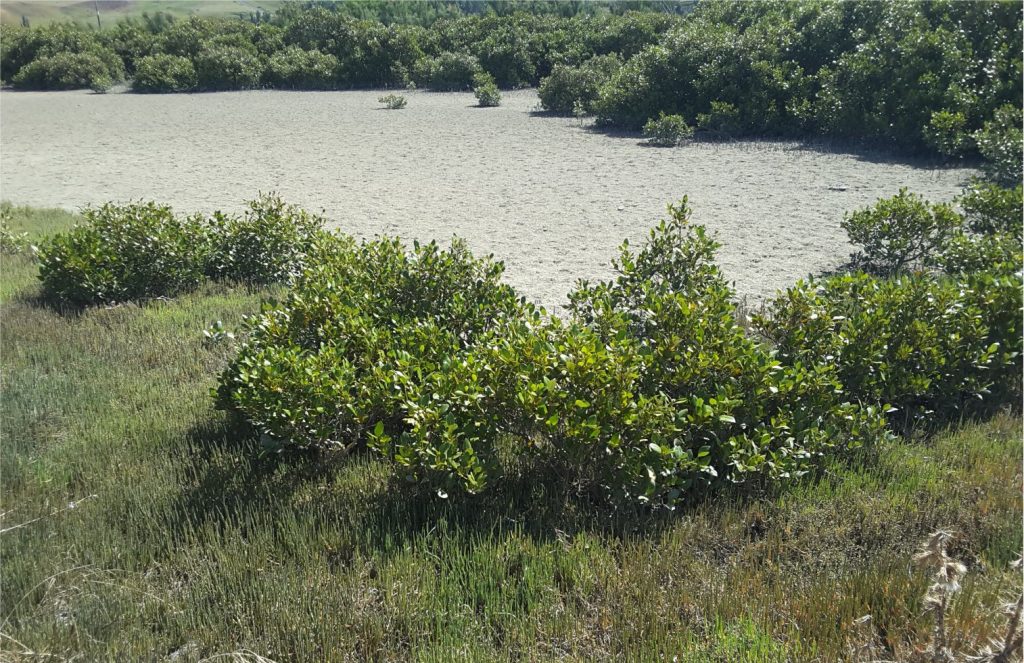
This post is part of the Lithofacies Series.
Manukau Harbour on the west edge of Auckland has several large estuarine inlets fringed by verdant mangrove forests. Residents along one of these inlets, Pahurehure Inlet, considered the mangroves an eyesore and a distraction from the real purpose of the waterway which was to provide easy access for kayaks, sandy beaches, and a safe space for recreation (Stuff report, 2010). After several years of lobbying the local council agreed in 2006 to clear part of the inlet of mangroves, an area of about 11 hectares (Lundquist et al., 2014). What the residents have been left with (as of 2023) is a slough, where thigh-deep anaerobic mud is pock-marked with rotting mangrove stumps, green algal slime, and in places a return of those accursed mangroves. Instead of sandy beaches the estuary is now fringed by salt marsh flora. Though unplanned, the overall result was predictable by anyone with a knowledge of coastal dynamics (tidal currents, sediment budgets and delivery) and coastal ecosystems.
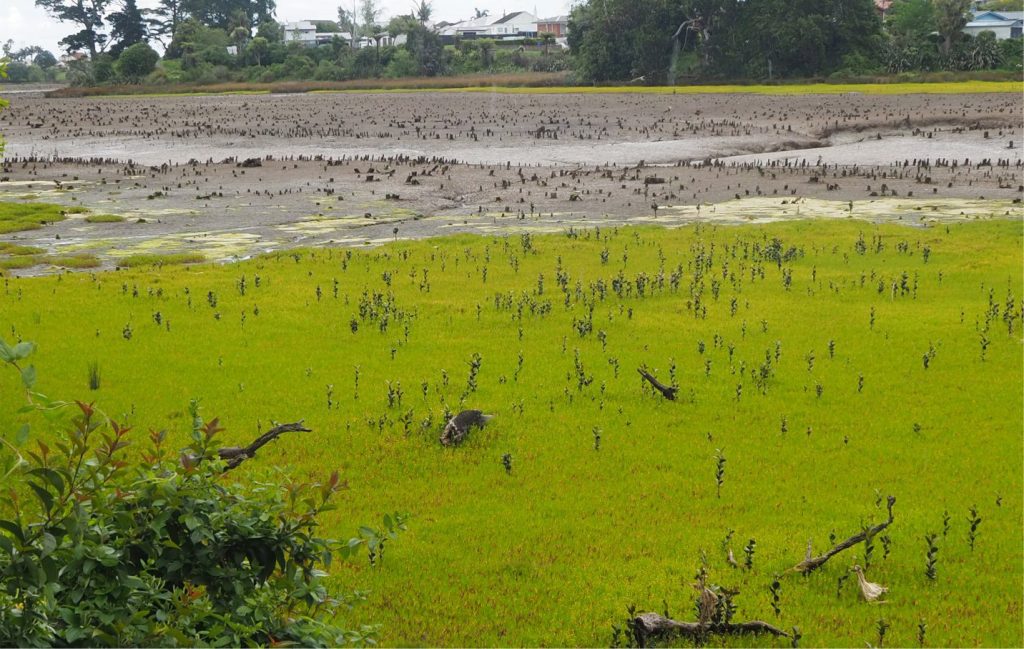
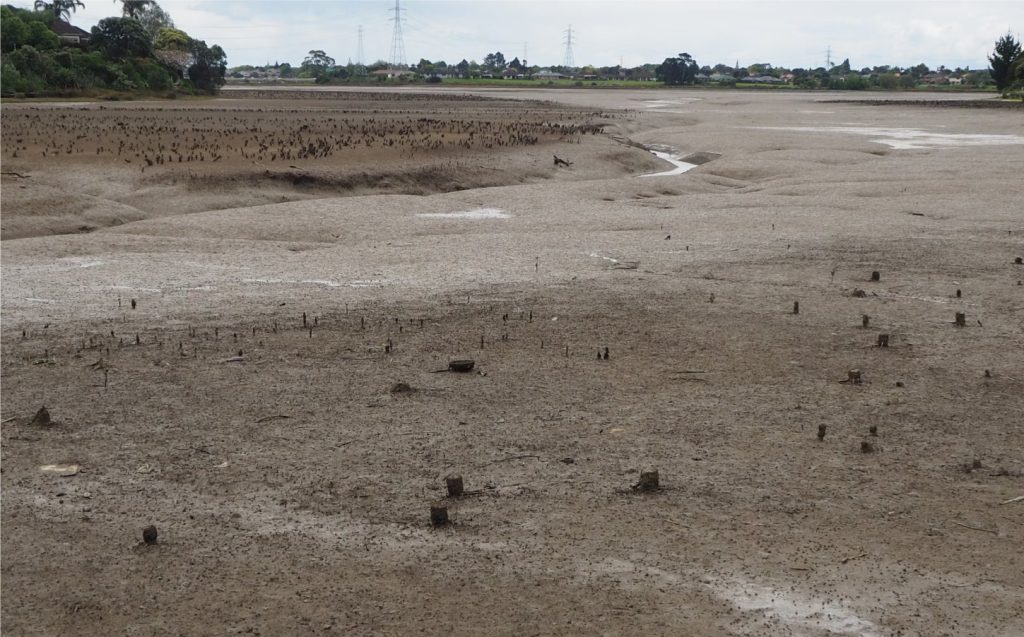
This is a familiar story along New Zealand coasts where mangroves once thrived – victims of coastal development with its concomitant sediment and contaminant runoff, and folk who need marina access for their boats. Indeed, it is a global story. Mangrove forests are one of the most productive of all marine ecosystems, and one of the most endangered. They are a vital part of the coastal food web, and act as nurseries for all manner of invertebrates, fish, mammals, and reptiles. Mangrove forests perform another vital task – they help to protect coasts because they are very efficient at damping storm-surge waves and currents.
Mangrove distribution
Mangroves have adapted to extreme physical conditions more than any other angiosperm. They grow at the intersection of fully marine and non-marine environments, having adapted to variable salinity and temperatures, tides and wind, storm surges, and soils that tend to be anaerobic.
Mangroves thrive in tropical and subtropical climates along coasts characterized by lagoons, embayments, delta plains, and estuaries. Their ability to grow in saline conditions means there is little competition for this niche from other vascular plants. Their present distribution generally ranges between latitudes 30o N and S, but in the southern hemisphere their range extends to 38o S in New Zealand and south Australia because of clement air and sea temperatures (Primavera et al., 2019).
Evolved mangrove morphology
Mangroves grow as trees that, given space, will develop as groves and extensive forests with dense canopies. In the tropics they can grow to heights of 24 m. In some regions, particularly the tropics, the marine wetland forests contain several mangrove species. Two of the most recognizable adaptations are their root systems and an ability to exclude or remove salt from their vascular system (Kathiresan and Bingham, 2001, PDF available).
Root development varies amongst different genera. Avicennia species grow a single trunk that extends directly from the muddy substrate. Its root system tends to be broad and shallow from which grow spongy pneumatophores that extend vertically a few 10s of centimetres above the sediment surface; their primary function is to enhance gas exchange when exposed to air (oxygen, carbon dioxide), and water exchange when submerged. The pneumatophores also provide a substrate for epiphytic algae and diverse invertebrate species.
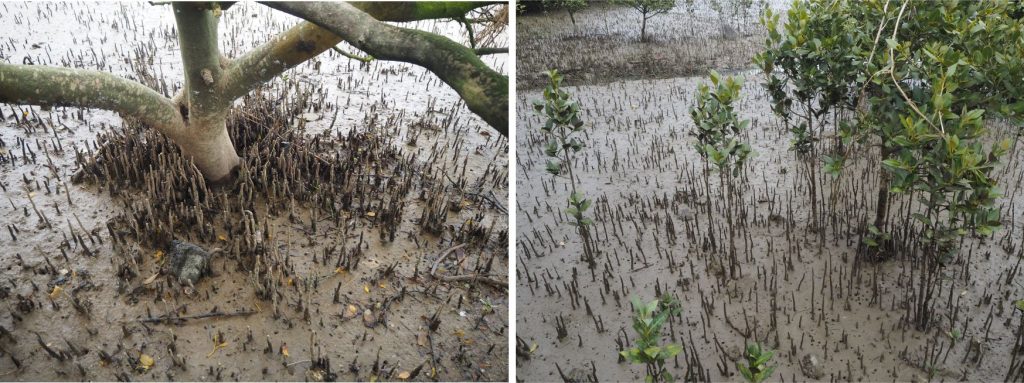
Rhizophora species have evolved fundamentally different root systems, with spectacular stilt-like structures that raise the main part of the tree above the sediment surface.
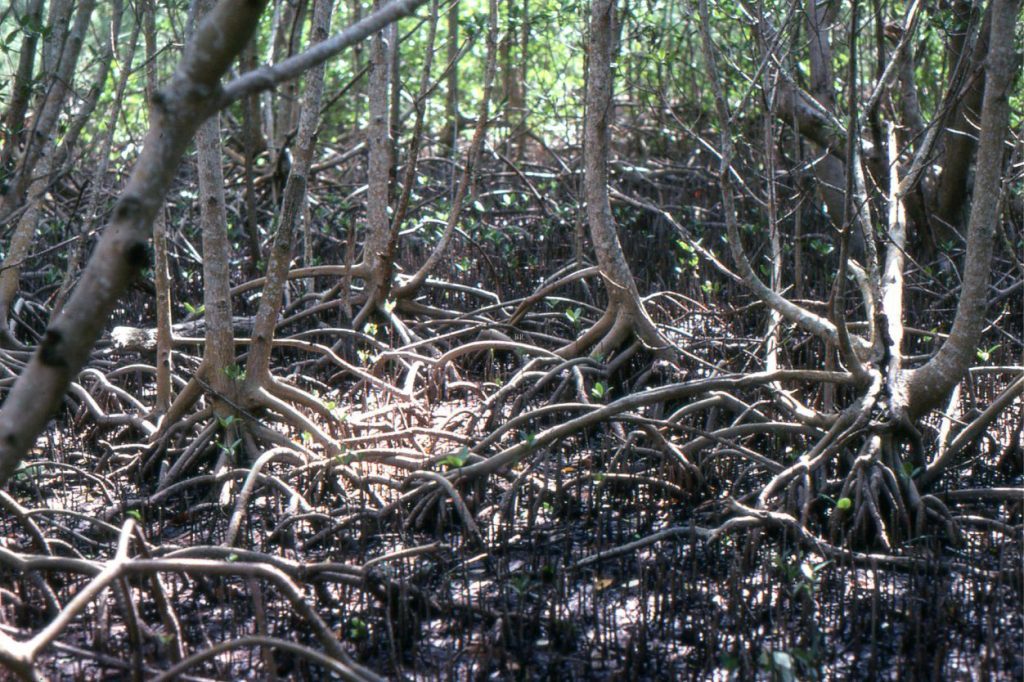
The third most common root system is the buttress type where large roots spread radially across the sediment-water interface (e.g., Xylocarpus). This root type stabilizes the tree in conditions where high winds and storm surges are frequent.
Mangrove leaves are thick and leathery. They have evolved the ability to reduce transpiration. Mangroves are angiosperms and produce flowers and seeds (also called propagules). Seed distribution and germination have evolved, like other mangrove traits, to survive saline conditions where dispersal is primarily by wind and tidal currents. Propagules can survive many months in transit to locations where they can put down roots.
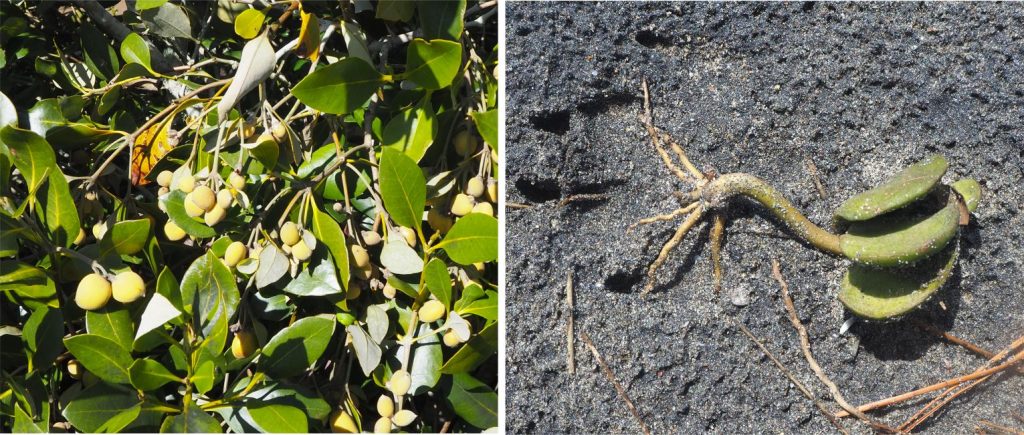
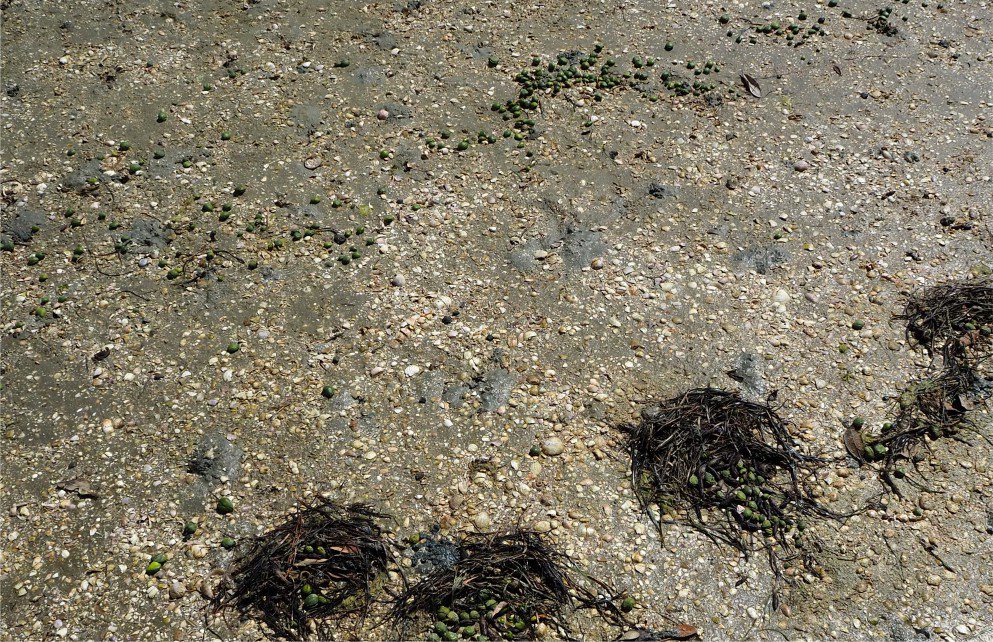
Salt exclusion
Most mangrove species can tolerate a range of salinities, from the barely saline (dilution by fresh water) to hypersaline. They have evolved very efficient processes for water uptake, salt exclusion, and prevention of excessive transpiration. Some species, like Rhizophora filter dissolved salt from soil moisture during uptake of water through their roots. In contrast, species like Avicennia absorb saline soil moisture and excrete the salt through special glands in their leaves (Kathiresan and Bingham, op cit.).
Associated flora
Mangroves have adapted to periodic submergence during tidal cycles, but not permanent submergence. Seagrass meadows are commonly found seaward of mangrove stands but the two do not usually co-mingle, partly because of shading by the canopy, and because there is little water movement where currents are damped by the root tangles.
At latitudes beyond the limits for mangrove growth, the niche is commonly occupied by salt marsh flora and fauna. Salt marsh wetland flora such as Salicornia and Spartina can also compete for space within mangrove belts.
Globally, macroalgae in mangrove wetlands are dominated by red and green species. Their presence and abundance depend on the amount of light that penetrates the canopy, the depth of tidal inundation, degree of desiccation, and salinity. Thus, these species are more likely to thrive near forest edges such as along tidal channel margins.
Associated fauna
Like seagrass communities, mangrove forests act as nurseries and food sources for many invertebrate and fish species, including in more tropical realms commercially valuable species of shrimp and prawn. Mangrove trunks, roots, and pneumatophores provide a reasonably stable substrate for encrusting and attached (epiphytic) invertebrates. Encrusting or cemented species include oysters, barnacles, sponges, and bryozoa. Mussels are attached by byssal threads. However, an overabundance of encrusting forms can also damage or kill trees because they prevent water and nutrient uptake – some species of gastropod will graze upon encrusting organisms.
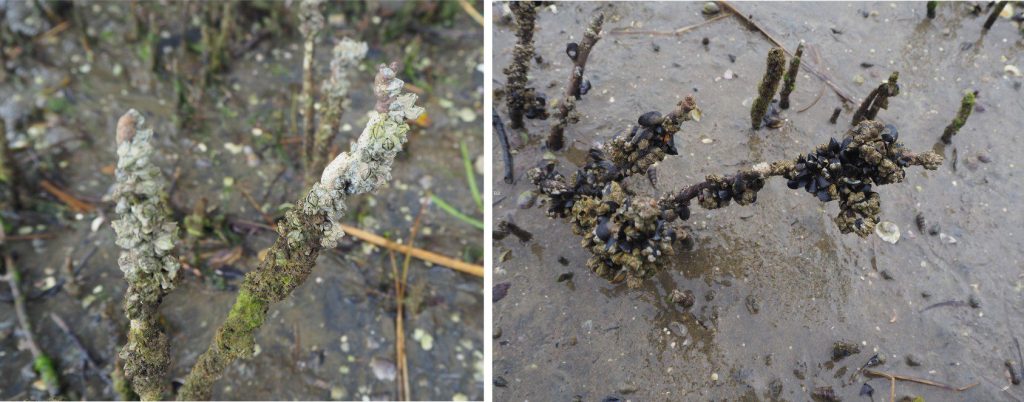
Most mangrove substrates are muddy and anaerobic within the first few centimetres below the surface. Tidal currents and wave wash tend to be weak. Benthic invertebrates that have adapted to these conditions include a variety of grazing and scavenging gastropods. In New Zealand this group of invertebrates is commonly dominated by crabs, worms, and gastropods like Amphibola crenata and Zeacumantus lutulentus that spend most of their time on the surface rather than burrowing, Wood-boring worms (Teredinids) are capable of significant damage to roots and the lower portions of tree trunks. Zooplankton also proliferate, particularly benthic and encrusting foraminifera, and radiolaria.
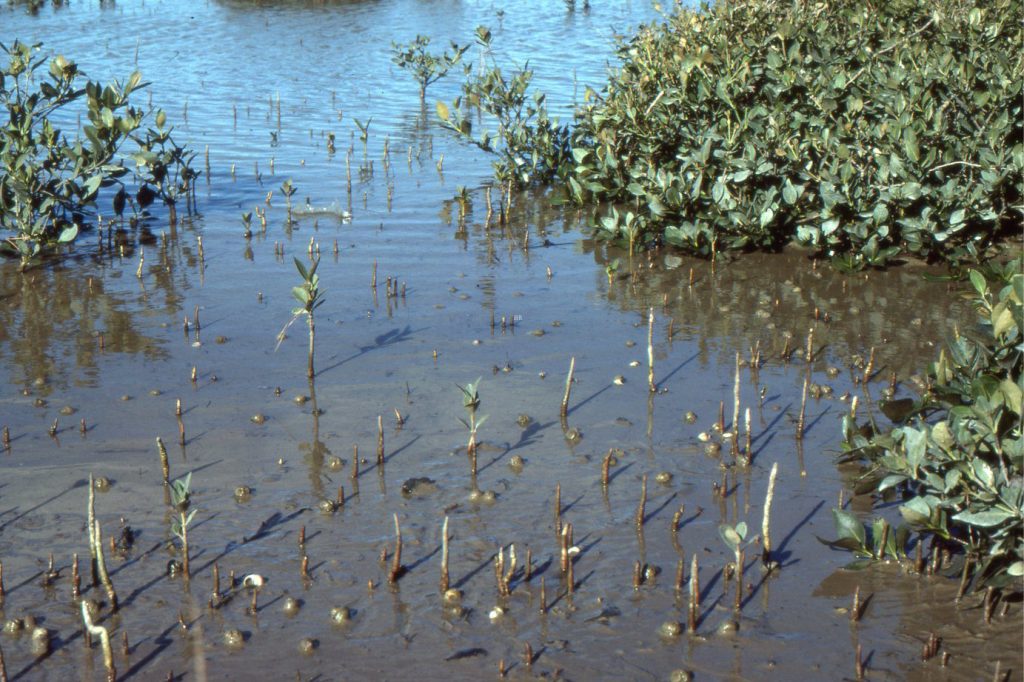
Large vertebrates can be prolific in species diversity and numbers. This includes many terrestrial mammals that venture from upland regions, birds, and reptiles including the tropical, more water-prone snakes and crocodilians.
Coastal protection
Mangrove forests provide one of the first lines of defense against storm surges along low-lying coasts (coastal plains, delta plains, estuaries and lagoons) (Temmerman et al., 2023, OA). The degree of storm wave attenuation depends on the density of mangrove tree growth (they usually grow with overlapping canopies), tree height, and the width of the forest belt. Flume experiments, and observations of natural systems indicate that storm wave dissipation also depends on mangrove species, where those that develop stilt roots are more effective at dissipating wave energy. This also applies to the potential reduction of tsunami inundation (Husrin et al., 2012, OA).
Experiments using the genus Rhizophora (that develops stilt roots) show that mangrove stands can reduce storm flood by 50%, and that a belt of trees 80 m wide can reduce wave height by up to 80% (Hashim and Pheng Catherine, 2013, PDF available). These empirical assessments also show a dependency on the severity and duration of storms. The results of these and other studies indicate the value of mangrove replanting in areas where forests have been removed, as a natural and relatively cheap method of coastal protection.
Links to the companion posts
Seagrass meadows and ecosystems

















